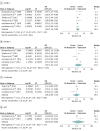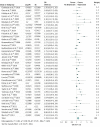Association of Microvascular Dysfunction With Late-Life Depression: A Systematic Review and Meta-analysis
- PMID: 28564681
- PMCID: PMC5710252
- DOI: 10.1001/jamapsychiatry.2017.0984
Association of Microvascular Dysfunction With Late-Life Depression: A Systematic Review and Meta-analysis
Abstract
Importance: The etiologic factors of late-life depression are still poorly understood. Recent evidence suggests that microvascular dysfunction is associated with depression, which may have implications for prevention and treatment. However, this association has not been systematically reviewed.
Objective: To examine the associations of peripheral and cerebral microvascular dysfunction with late-life depression.
Data sources: A systematic literature search was conducted in MEDLINE and EMBASE for and longitudinal studies published since inception to October 16, 2016, that assessed the associations between microvascular dysfunction and depression.
Study selection: Three independent researchers performed the study selection based on consensus. Inclusion criteria were a study population 40 years of age or older, a validated method of detecting depression, and validated measures of microvascular function.
Data extraction and synthesis: This systematic review and meta-analysis has been registered at PROSPERO (CRD42016049158) and is reported in accordance with the PRISMA and MOOSE guidelines. Data extraction was performed by an independent researcher.
Main outcomes and measures: The following 5 estimates of microvascular dysfunction were considered in participants with or without depression: plasma markers of endothelial function, albuminuria, measurements of skin and muscle microcirculation, retinal arteriolar and venular diameter, and markers for cerebral small vessel disease. Data are reported as pooled odds ratios (ORs) by use of the generic inverse variance method with the use of random-effects models.
Results: A total of 712 studies were identified; 48 were included in the meta-analysis, of which 8 described longitudinal data. Data from 43 600 participants, 9203 individuals with depression, and 72 441 person-years (mean follow-up, 3.7 years) were available. Higher levels of plasma endothelial biomarkers (soluble intercellular adhesion molecule-1: OR, 1.58; 95% CI, 1.28-1.96), white matter hyperintensities (OR, 1.29; 95% CI, 1.19-1.39), cerebral microbleeds (OR, 1.18; 95% CI, 1.03-1.34), and cerebral (micro)infarctions (OR, 1.30; 95% CI, 1.21-1.39) were associated with depression. Among the studies available, no significant associations of albuminuria and retinal vessel diameters with depression were reported. Longitudinal data showed a significant association of white matter hyperintensities with incident depression (OR, 1.19; 95% CI, 1.09-1.30).
Conclusions and relevance: This meta-analysis shows that both the peripheral and cerebral forms of microvascular dysfunction are associated with higher odds of (incident) late-life depression. This finding may have clinical implications because microvascular dysfunction might provide a potential target for the prevention and treatment of depression.
Conflict of interest statement
Figures




References
-
- World Health Organisation World health statistics 2007. http://www.who.int/whosis/whostat/2007/en/. Accessed October 16, 2016.
-
- Whiteford HA, Degenhardt L, Rehm J, et al. . Global burden of disease attributable to mental and substance use disorders: findings from the Global Burden of Disease Study 2010. Lancet. 2013;382(9904):1575-1586. - PubMed
-
- Driscoll HC, Basinski J, Mulsant BH, et al. . Late-onset major depression: clinical and treatment-response variability. Int J Geriatr Psychiatry. 2005;20(7):661-667. - PubMed
-
- Hardeveld F, Spijker J, De Graaf R, et al. . Recurrence of major depressive disorder across different treatment settings: results from the NESDA study. J Affect Disord. 2013;147(1-3):225-231. - PubMed
-
- Hardeveld F, Spijker J, De Graaf R, Nolen WA, Beekman AT. Prevalence and predictors of recurrence of major depressive disorder in the adult population. Acta Psychiatr Scand. 2010;122(3):184-191. - PubMed
Publication types
MeSH terms
LinkOut - more resources
Full Text Sources
Other Literature Sources

